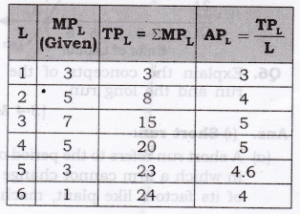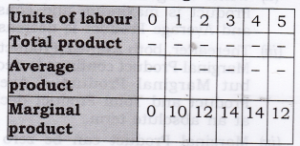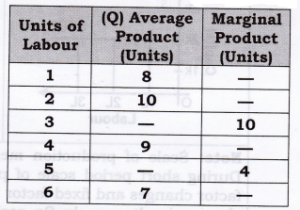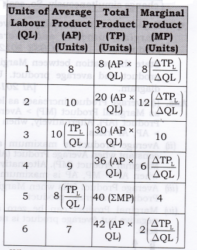Question 1. Explain the concept of a production function.
Answer: The relationship between physical input and physical output of a firm is generally referred to as production function.
The general form of production
function is, q = f (x1 : x2)
where, q = output, x1 = 1 input like labour, x2 = another input like machinery
Question 2. What is the total product of an input?
Answer: Total product of an input refers to total volume of goods and services produced by a firm with the given inputs during a specified period of time.
Question 3. What is the average product of an input?
Answer: Average Product of am input is per unit product of variable factors. It is calculated by dividing the total Product by the units of variable factor.
Average Product =TotalProductUnitofVariableFactor
Question 4. ‘What is the marginal product of an input?
Answer: Marginal Product of an input is an addition to the total product when an additional unit of a variable factor is employed.
MP=ChangeinoutputChangeininput=ΔqΔL
Question 5. Explain the relationship between the marginal products and the total product of an input.
Or [AI 05, 07; CBSE 05, 06, 07] Explain the law of variable proportion with the help of total product and marginal product curves.
Explain the likely behaviour of Total Product and Marginal Product when for increasing production only one input is increased while all other inputs are kept constant.
State the different phases of changes in Total Product and Marginal Product in the Law of Variable Proportions. Also show the same in a single diagram.
Answer: According to the Law of Variable Proportion when only one input is increased while all other inputs are kept constant, Marginal Product and Total Product behave in the following manner:
1. When Marginal product rises (till Point P1), Total product increases at an increasing rate (convex shape) (till point P).
2. When Marginal product falls and remains positive (Till point B1), total product increases at a diminishing rate (concave shape) (till point A),
3. When Marginal Product is zero (at point B1), Total Product is at its maximum and constant (At point B),
4. When Marginal product becomes negative (after point B1), total product falls (after point B).
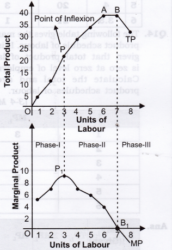
Question 6. Explain the concepts of the short run and the long run.
Answer:
1. Short run:
(a) A short run refers to the period of time in which a firm cannot change some of its factors like plant, machinery, building, etc. due to insufficiency of time but can change any variable factor like labour, raw material, etc.
(b) Thus, in short run, there will be some factors of production that are fixed at predetermined levels, e.g., a farmer may have fixed amount of land,
2. Long run:
(a) A long run is a time period during which a firm can change all its factors of production including machines, building, organization, etc.
(b) In other words, it is a period of time during which supplies can adjust itself to change in demand.
Note:
(i) Mind, here the terms long run and short run are functional and do not refer to a calendar month or a year,
(ii) This distinction depends merely upon how quickly factor inputs can be change by producers in an industry.
Question 7. What is the law of diminishing marginal product?
Answer: The Law of diminishing marginal product states that when we applied more and more units of variable factor to a given quantity of fixed factor, total product increases at a diminishing rate and marginal product falls.
Question 8. What is the law of variable proportions?
Or
Define the law of variable proportion.
Answer: The law of variable proportion states that as we increase the quantity of only one input, keeping other inputs fixed, the total product increases at an increasing rate in the beginning, then increases at decreasing rate and after a level the output ultimately falls.
Question 9. The following table gives the total product schedule of labour. Find the corresponding average product and marginal product schedules of labour.
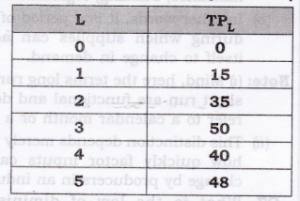
Answer:
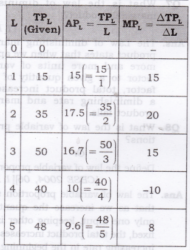
Question 10. The following table gives the average product schedule of labour. Find the total product and marginal product schedules. It is given that the total product is zero at zero level of labour employment.

Answer:
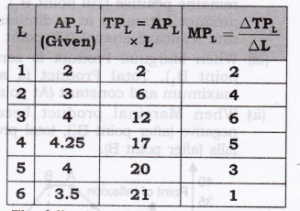
Question 11. The following table gives the marginal product schedule of labour. It is also given that total product of labour is zero at zero level of employment. Calculate the total and average product schedules of labour.
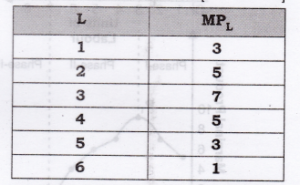
Answer:
Question 12. Let the production function of a firm be Q=L1/2K1/2 Find out the maximum possible output that the firm can produce with 100 units of L and 100 units of K.
Answer: Q=5L1/2K1/2(Given)Q=5×1001/2×1001/2
Q = 5 x 10 x 10 = 500 units So, the maximum possible output(Q) = 500 units.
I. Very Short Answer Type Questions
Question 1. Give the meaning of production function.
Define production function.
Answer: The relationship between physical input and physical output of a firm is generally referred to as production function.
Question 2. In which run some factors of production are fixed and others are variable?
Answer: Short run.
Question 3. What change will take place in marginal product when total product increases at a diminishing rate?
Answer: Marginal product will decline but remains positive.
Question 4. In which phase of Law of Variable Proportions a rational firm aims to operate?
Answer: Diminishing returns to a factor (Phase 2).
Question 5. What is meant by diminishing returns to a factor?
Answer: Diminishing returns to a factor refer to a phase when total product increases at a decreasing rate and marginal product falls, but remains positive with the increase in variable factor.
Question 6. What is the general shape of the AP and MP curves?
Answer: AP and MP curves are inversely U-shaped.
Question 7. How does fall in marginal production affect total output?
Answer: Fall in marginal product affects the total output in the following two manners:
1. When marginal product falls, but remains positive, total product increases at a diminishing rate.
2. When marginal product falls and become zero, total product falls in its absolute terms.
Question 8. Why MP curve cuts AP curve at its maximum point?
Answer: It happens because when AP rises, MP is more than AP. When AP falls, MP is less than AP. So, it is only when AP is constant and at its maximum point that MP is equal to AP. Therefore, MP curve cuts AP curve at its maximum point.
Question 9. Can AP rise when MP starts declining?
Answer: Yes, AP can rise when MP starts declining. It can happen as long as falling MP is more than AP. However, when MP becomes equal to AP, further decline in MP will also reduce AP.
Question 10. What is the shape of AP and MP?
Answer: Inverse U-Shaped.
Question 11. Give meaning of “Return to a Factor”.
Answer: Return to a factor states that change in the physical output of a good when only the quantity of one input is increased, while that of other input is kept constant
II. Short Answer Type Questions
Question 1. Differentiate between Short Period and Long Period.
Answer:
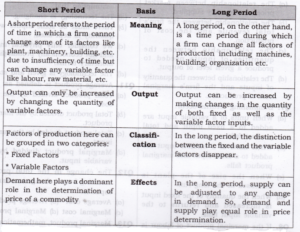
Question 2. Differentiate between Short Period production and Long Period production function.
Answer:
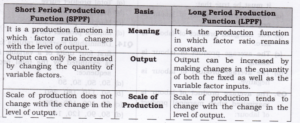
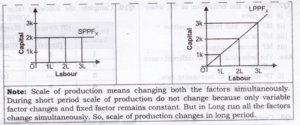
Question 3. Explain the relationship between Marginal product and Average Product. Or
State the relation between Marginal product and average product. Use diagram.
Answer:
1. Average Product increases as long as Marginal Product (MP) > Average Product (AP). Alternatively, when MP > AP, AP rises.
2. Average Product is maximum and constant when Average Product (AP) = Marginal Product (MP). Alternatively, when AP = MP, AP is maximum.
3. Average Product falls when Marginal Product < Average product.
4. Marginal Product can be zero and negative but Average product is never zero.
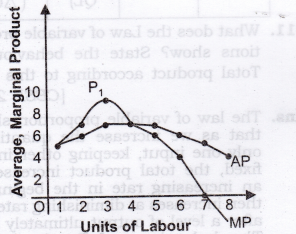
Question 4. Explain the relationship between Total Product and Average Product.
Answer:
1. When Total Product increases at an increasing rate, Average Product also increases.
2. When Total Product increases at a diminishing rate, Average Product declines.
3. Since Total Product is always positive, Average Product also remains throughout positive.
Question 5. Explain the relationship between Total Product, Average Product and Marginal Product.
Answer:
1. In the beginning Total Product, Average Product and Marginal Product all increase, but Marginal Product > Average Product and Total Product > Marginal Product.
2. When Marginal Product = 0, Total Product is maximum and constant and Average Product is decreasing.
3. Thereafter, both Average Product and Marginal Product continue to decline, but Marginal Product < Average Product and Total Product declines at an absolute term.
4. Marginal Product can be zero and negative but Average Product and Total Product can never be zero.
Question 6. What is the reaction of AP, when:
1. MP is more than AP.
2. MP is less than AP.
3. MP is equal to AP.
Answer: The reaction of AP in different cases will be:
1. AP will rise.
2. AP will fall but it will remain positive.
3. AP will be constant and at its maximum point.
Question 7. What is the behaviour of TP, when
1. MP rises
2. MP fails, but remains positive
3. MP is zero
4. MP becomes negative?
Answer: The behaviour of TP in different cases will be:
1. TP increases at increasing rate.
2. TP increases at diminishing rate,
3. TP is at its maximum and constant.
4. TP decreases.
Question 8 . Complete the following table.
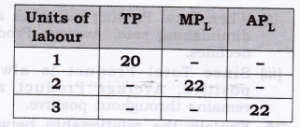
Answer:
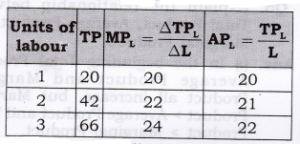
Question 9. Complete the following table.
Answer:

Question 10. Complete the following table:
Answer:
Question 11. What does the Law of variable proportions show? State the behaviour of Total product according to this Law.
Answer: The law of variable proportion shows that as we increase the quantity of only one input, keeping other inputs fixed, the total product increases at an increasing rate in the beginning, then increases at diminishing rate and after a level of output ultimately falls. The behaviour of Total product according to this law is as under:
1. TP increases continuously from points O to A.
2. It increases at an increasing rate (convex shape) from O to P and at a diminishing rate (concave shape) from P to A.
3. TP is maximum at A and remains so up to point B.
4. After Point B, Total Product falls.
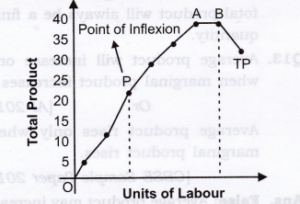
Question 12. Complete the following table:
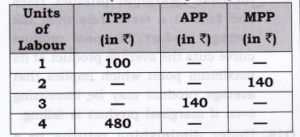
Answer:



